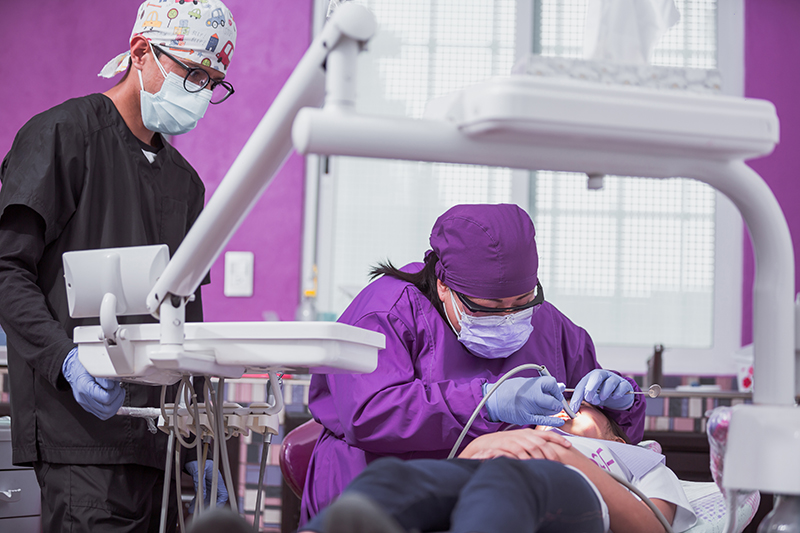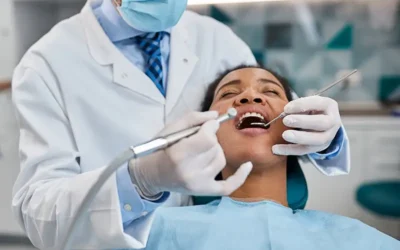Dental professionals perform a wide range of preventive, nonsurgical and surgical procedures. Periodontics is a specialized field dedicated to the prevention, diagnosis, and treatment of disease relating to the gums and other tissue and underlying bones that support the teeth. In addition, periodontists place and repair dental implants.
Accurate coding for periodontics and oral surgery requires using specific ADA dental procedure codes or CDT codes for procedures and ICD-10-CM codes for diagnoses. In cases where dental care overlaps with medical care, CPT codes can be used to report medical treatments to medical plans. Precise coding is essential for practices to ensure proper dental billing to support both clinical care, compliance, and financial health.
However, dental practices often lose revenue when coding errors lead to claim denials or underpayments. Partnering with a dental billing company offering technology-enabled, AI-driven solutions can significantly improve coding accuracy for periodontics and oral surgery. These advanced tools automate code selection, reduce human error, and ensure faster, cleaner dental claims submission.
This post discusses how to code periodontal scaling and root planing procedures and oral surgery, including tips for minimizing dental claim denials.
Optimize your dental billing with our AI-enabled solutions for faster, error-free claims.
CDT Codes for Periodontal Scaling and Root Planing
Periodontal scaling and root planing codes are used to report procedures to remove plaque and tartar from the teeth and smooth the root surfaces to prevent bacteria from reattaching. Periodontal procedure coding also includes codes for soft tissue management, bone grafting, and regenerative procedures aimed at preventing, diagnosing, and surgically treating diseases of the tooth-supporting structures.
Frequently used codes for periodontal maintenance and scaling and root planning:
- Periodontal Maintenance :
D4910 – Periodontal Maintenance
This covers the removal of bacterial plaque and calculus both above and below the gumline, site-specific scaling and root planing where indicated, and teeth polishing.
D4910 is for ongoing maintenance following periodontal treatment and not for routine prophylaxis.
- Scaling and Root Planing (SRP)
These therapeutic procedures are used to treat active periodontal disease by removing plaque, calculus, and bacteria from below the gumline.
D4341 – Periodontal Scaling and Root Planing – Four or More Teeth per Quadrant
Used when four or more teeth in a quadrant require SRP due to periodontal disease.
D4342 – Periodontal Scaling and Root Planing – One to Three Teeth per Quadrant
Used when one to three teeth in a quadrant need SRP.
Both D4341 and D4342 require documentation of periodontal pocketing and bone loss. Radiographs and charting must support the necessity of SRP.
- Prophylaxis
Prophylaxis is a preventive cleaning to help keep the teeth and gums healthy. It can help evaluate the risk of periodontal disease and spot signs of other dental problems.
D1110 – Prophylaxis – Adult
For patients without periodontal disease; includes scaling and polishing to remove plaque, calculus, and stains.
D1120 – Prophylaxis – Child
For preventive cleaning in children without signs of periodontitis.
- Additional Related Codes
D4346 – Scaling in Presence of Generalized Moderate or Severe Gingival Inflammation
D4346 is reported when there is inflammation but no attachment loss; used prior to SRP or maintenance therapy.
D4911 – Periodontal Maintenance – One to Five Teeth
This code is not accepted by all payers. It is used in some cases when maintenance involves a limited number of teeth.
CDT Codes for Oral Surgery
Oral surgery includes a wide range of procedures on the mouth and jaw, such as wisdom tooth and other tooth extractions, dental implant placement, and bone and gum grafts. More complex procedures can also include reconstructive surgery for facial deformities, jaw surgery, and treatment for oral cancers or trauma. Here are the common CDT codes used in oral surgery billing:
- Tooth Extractions
D7140 – Extraction, Erupted Tooth or Exposed Root (Elevation and/or Forceps Removal)
Standard code for simple tooth extraction without surgical intervention.
D7210 – Surgical Removal of Erupted Tooth Requiring Removal of Bone and/or Sectioning of Tooth, and Including Elevation of Mucoperiosteal Flap if Indicated
Used when bone removal or tooth sectioning is necessary—often mistaken for a simple extraction.
D7220 – Removal of Impacted Tooth, Soft Tissue
For soft tissue–impacted teeth requiring only mucoperiosteal flap elevation.
D7230 – Removal of Impacted Tooth, Partially Bony
When part of the tooth is covered by bone and requires partial removal for access.
D7240 – Removal of Impacted Tooth, Completely Bony
Complete bone coverage requiring extensive surgical access.
D7241 – Removal of Impacted Tooth, Completely Bony, with Unusual Surgical Complications
For complex cases involving nerve repositioning, excessive bone removal, or abnormal root morphology.
- Surgical Procedures
D7280 – Surgical Access of an Unerupted Tooth
Used when bone and/or soft tissue must be removed to expose an unerupted tooth (e.g., for orthodontic treatment).
D7283 – Placement of Device to Facilitate Eruption of Impacted Tooth
Often reported along with D7280 when an attachment or device is placed.
D7291 – Transseptal Fiberotomy/Supracrestal Fiberotomy, Per Tooth
Used to help prevent relapse of tooth rotation following orthodontic treatment.
D4260 – Osseous Surgery (Including Flap Entry and Closure) – Four or More Contiguous Teeth or Tooth-Bounded Spaces per Quadrant. (Periodontal surgery to reduce pockets and reshape bone).
- Bone Grafts and Related Procedures
D4263 – Bone Replacement Graft – Retained Natural Tooth
Graft to regenerate bone around existing teeth.
D4264 – Bone Replacement Graft – Ridge Preservation – Per Site
Used after extraction to preserve the alveolar ridge.
D7951 – Sinus Augmentation via a Lateral Open Approach
Bone graft to increase bone height in the posterior maxilla.
- Soft Tissue and Flap Procedures
D4270 – Pedicle Soft Tissue Graft
For root coverage using adjacent soft tissue.
D4271 – Free Soft Tissue Graft (Including Donor Site Surgery), First Tooth or Edentulous Tooth Position in Graft
Commonly used for gingival augmentation.
- Regenerative Procedures (Guided Tissue or Bone Regeneration)
D4266 – Guided Tissue Regeneration – Resorbable Barrier, Per Site
Used when a resorbable membrane is placed to facilitate periodontal regeneration.
D4283 – Autogenous Connective Tissue Graft Procedures (Per Tooth or Tooth Site)
For regenerative grafts using the patient’s own tissue.
- Other Frequently Used Oral Surgery Codes
D7285 – Biopsy of Oral Tissue – Hard (Bone, Tooth)
D7286 – Biopsy of Oral Tissue – Soft
D7471 – Removal of Lateral Exostosis (Maxilla or Mandible)
D7472 – Removal of Torus Palatinus
D7473 – Removal of Torus Mandibularis
D7510 – Incision and Drainage of Abscess – Intraoral Soft Tissue
D7520 – Incision and Drainage of Abscess – Extraoral Soft Tissue
Insurance Coding for Periodontal Treatments and Oral Surgery – Common Challenges
Incomplete or inconsistent coding is one of the most common reasons for dental claim denials. Coding for periodontics and oral surgery demands precision. These specialties involve complex procedures that overlap with general dentistry, prosthodontics, and even medical billing in some cases. Because each payer interprets CDT (Current Dental Terminology) and CPT (Current Procedural Terminology) codes differently, even small errors in coding or documentation can result in denials or payment delays.
Understanding the most common coding challenges that lead to can help dental practices protect revenue and reduce rework. Here are the key challenges that practices face when reporting periodontics and oral surgical procedures:
- Choosing the Correct CDT Code
Differentiating between CDT codes to select the correct code for scaling, root planing, and debridement procedures is one of the biggest challenges in periodontal billing. For example:
- D4341 (SRP – four or more teeth per quadrant) and D4342 (SRP – one to three teeth per quadrant) are often misused.
- While D4910 (Periodontal maintenance) is used for patients with a history of active periodontal therapy, this code may be incorrectly applied for routine prophylaxis.
Incorrect selection or sequencing of these codes leads to payer denials due to “lack of medical necessity” or “inappropriate procedure for diagnosis.”
- Cross-Coding Dental and Medical Claims
In oral surgery, procedures involving biopsies, bone grafts, or extractions may fall under medical rather than dental billing when performed in a surgical or hospital setting. For example, if medically necessary, a complex alveoloplasty or bone graft may be billed under CPT 21210 (graft, bone; nasal, maxillary, or mandibular) instead of CDT D7953 (bone replacement graft for ridge preservation). Knowing how to cross-code oral surgery procedures to medical billing is crucial in such cases.
Avoiding confusion Between CDT and CPT codes requires understanding payer-specific crossover rules and medical necessity documentation. However, many dental offices lack medical billing expertise or fail to attach required narratives, radiographs, or pathology reports to justify medical necessity.
- Documentation Gaps
Documentation gaps are one of the leading causes of denials in both periodontics and oral surgery billing. Claims submitted without the following elements will be denied:
- Pre- and post-operative radiographs.
- Periodontal charting (pocket depths, mobility, recession).
- Clinical notes describing the extent of infection, bone loss, or trauma.
- Histopathology reports for biopsy claims.
Without proper documentation, even claims that are coded correctly, will face denial.
- Bundled and Inclusive Procedures
Payers often bundle certain procedures, which means one code is considered part of another and not payable separately. Incorrectly grouping or separating procedures can lead to claim denials and lost revenue. Examples of bundling:
- Bone grafts (D4263/D4264) may be bundled with osseous surgery (D4260/D4261).
- In oral surgery, anesthesia or incision and drainage might be bundled into the surgical code.
Knowing each payer’s bundling rules is essential to prevent duplicate coding and missed reimbursement opportunities.
- Site-Specific and Quadrant Coding Errors
Many periodontal and surgical codes require tooth numbers or quadrant identification. Omitting these details can lead to confusion during review by the payer and claim rejection. Examples of common mistakes:
- D4260 (osseous surgery) applies when treating four or more contiguous teeth or tooth-bounded spaces per quadrant. If fewer teeth are involved, reporting D4260 will result in denial—the correct code to use is D4261.
- Not specifying the quadrant (UR, UL, LR, LL) when billing D4260
- Submitting code D4249 (clinical crown lengthening) without tooth numbers
Both the claim form and the clinical notes should include the exact location—quadrant or tooth numbers.
- Frequency and Time Limitations
Each payer enforces different limitations for repeating periodontal or surgical procedures.
For example, SRP (D4341/D4342) is usually limited to once every 24–36 months per quadrant.
Challenge: Practices must verify plan frequency limits before treatment to prevent denials for “procedure frequency exceeded.”
- Coding Surgical Complications and Follow-Ups
Coding follow-up care after complications can be tricky. Post-surgical issues like infection or bleeding may not be billable within the global period unless a separate, documented procedure, such as an incision and drainage, is performed.
- Errors in Anesthesia Coding
Oral surgery often requires sedation or general anesthesia. CDT codes D9222 and D9223 are for billing deep sedation or general anesthesia in dental procedures.
When using these codes, reporting per-visit instead of per-15-minute increments, can trigger payer adjustments or recoupments. Confirming the payer’s anesthesia billing unit definition and documentation requirements before submission helps avoid errors.
Essential Guidelines for Accurate Periodontal and Dental Surgery Coding and Billing
Common CDT coding mistakes include using outdated CDT codes, incorrect code selection for scaling, root planing, or surgical extractions, dental-medical cross-coding issues, and missing documentation for medical necessity. Here are top tips to avoid dental billing and coding errors:
- Verify payer policies: Review each payer’s coverage criteria, frequency limits, and bundling rules before submitting claims.
- Ensure detailed documentation: Include periodontal charting, radiographs, and clinical narratives supporting medical necessity.
- Use correct CDT codes: Choose codes that reflect the exact procedure, number of teeth treated, and quadrant involved (e.g., D4260 vs. D4261). Stay up to date with CDT code changes, and double-check CDT code definitions and payer bundling rules before claim submission. Know how to cross-code oral surgery procedures to medical billing.
- Report site-specific details: Always indicate tooth numbers or quadrants for localized procedures.
- Check prior authorization requirements: Obtain approval for surgeries like osseous surgery, grafting, or flap procedures when required.
- Avoid coding overlaps: Don’t report codes that payers consider inclusive or bundled together.
- Confirm frequency and time limits: Many periodontal procedures are covered only once every 24–36 months per quadrant.
- Maintain sequencing accuracy: Ensure that active therapy (e.g., scaling and root planing) precedes maintenance codes (e.g., D4910).
- Validate patient eligibility and benefits: Confirm active coverage and remaining annual benefit before treatment.
- Ensure coding compliance during post-op care: Bill separately only when complications require distinct procedures outside the global period.
- Submit complete claims: Attach all required documentation, narratives, and diagnostic materials.
- Maintain clear referral documentation: Ensure treatment plans and authorization notes exchanged between general dentists, periodontists, and oral surgeons are clearly documented to support continuity of care and payer compliance.
- Perform internal audits: Regularly review coding accuracy and denial patterns to improve billing performance.
Value of Expert Dental Coding Support
Accurate coding for periodontics and oral surgery is essential to prevent claim denials, optimize reimbursements, and maintain compliance with payer requirements. By following best practices, including dental insurance verification, proper dental documentation, precise CDT code selection, and adherence to frequency and prior authorization rules, practices can significantly improve coding accuracy. Partnering with AI-enabled dental billing services can streamline the process, automating claim submissions, reducing human errors, and ensuring faster, cleaner reimbursements. Leveraging advanced technology not only enhances coding accuracy but also allows dental practices to focus on delivering high-quality patient care without the distraction of administrative burdens.
Boost coding accuracy & reimbursements with technology-driven dental billing services.




